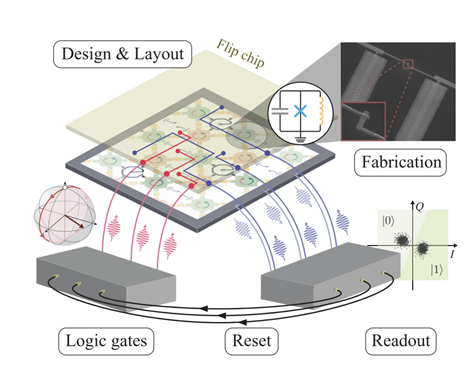Quantum Computing of an Atomic Nucleus
The first-ever computation of an atomic nucleus, the deuteron, on a quantum chip demonstrates that even today’s rudimentary quantum computers can solve nuclear physics questions.

The Science
A simple but realistic problem in nuclear physics, such as the computation of the deuteron’s binding energy, can be solved via quantum computing on existing quantum devices.
The Impact
Scientists simulated an atomic nucleus using a quantum computer. The results demonstrate that quantum systems can solve nuclear physics problems that explain how the building blocks of our universe work. The quantum computing of the lightest atomic nucleus is the first step toward scalable computations of heavier nuclei on quantum processor units. The computation via cloud access also opens the field of quantum computing to a large group of scientists.
Summary
Quantum computers promise to solve “exponentially hard” problems, such as computing the structure of molecules, atoms, or atomic nuclei. A collaboration of nuclear physicists and quantum information scientists at Oak Ridge National Laboratory reported on the first quantum computation of the deuteron, the lightest atomic nucleus, using publicly available software and accessing quantum processors via the cloud. To accomplish this feat, they employed a simple-yet-realistic model for the deuteron and tailored the calculation to the constraints imposed by cloud computing on noisy quantum chips. The quantum computation yielded the deuteron’s binding energy to within a few percent of precision, making this the first step toward scalable nuclear structure computation on quantum processor units.
Contact
Thomas Papenbrock
Physics Division, Oak Ridge National Laboratory and Department of Physics & Astronomy, University of Tennessee
tpapenbr@utk.edu
Funding
This material is based upon work supported by the Department of Energy (DOE), Office of Science, Office of Nuclear Physics, and fieldwork proposals at Oak Ridge National Laboratory (ORNL). This material is also based upon work supported by the DOE, Office of Science, Office of Advanced Scientific Computing Research (ASCR) quantum algorithms and testbed programs and used resources of the Oak Ridge Leadership Computing Facility located at ORNL, which is supported by the DOE Office of Science ASCR.
Publications
E.F. Dumitrescu, A.J. McCaskey, G. Hagen, G.R. Jansen, T.D. Morris, T. Papenbrock, R.C. Pooser, D.J. Dean, and P. Lougovski, “Cloud quantum computing of an atomic nucleus.” Physical Review Letters 120, 210501 (2018). [DOI: 10.1103/PhysRevLett.120.210501]
Related Links
Oak Ridge National Laboratory press release: Nuclear physicists leap into quantum computing with first simulations of atomic nucleus
APS Physics article: Viewpoint: Cloud quantum computing tackles simple nucleus
Highlight Categories
Performer: University , DOE Laboratory , SC User Facilities , ASCR User Facilities , OLCF



